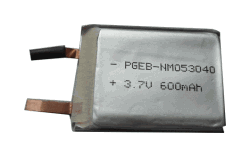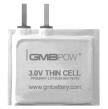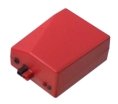
| July 8, 2024 | |||
Primary and secondary lithium cells with low magnetism |
 New: non-magnetic lithium polymer rechargeable cells.  Non-rechargeable lithium polymer cells can also be made non-magnetic  Battery capacity tester for small and tiny cells |
||
| Introduction: Occasionally there is a need for batteries that are non-magnetic. Our research into this area has turned up the lithium metal manganese dioxide cells as a possibility. There is some paramagnetism in the manganese dioxide, since it has 3 unpaired electrons, but the main source of ferromagnetism is the case. These cells use non-magnetic stainless steel due to the chemical properties of the steel. However, non-magnetic stainless is only non-magnetic until it is deformed. When the annealed steel sheet is drawn to form the case the crystal structure is disrupted, converting some of the austentite to martensite and it becomes slightly ferromagnetic. This means that our CR series cells have far less ferromagnetism than other steel-cased cells, but it also means that if you have a strong enough magnet they will be attracted to it. These pseudo-non-magnetic cells have been found useful in many areas, but they are not good enough for others. Another option is the lithium thionyl chloride 3.6V cells. They use the same stainless steel as the manganese dioxide cells, but they do have a center rod that is glass-frit sealed into the top. In order to make a good seal with the glass the rod is made out of Kovar, an Ni-Co-Fe alloy that is very magnetic, though it weighs less than a gram in most cells. The key is in testing the battery in your application, not necessarily testing them with a Nd-B magnet. Lithium polymer and lithium metal pouch cells. We have the technology to make lithium polymer cells without nickel. These are rechargable, but have been used in non-recharge applications. In addtion we can make the primary lithium metal pouch cells non-magnetic, please call for a quote. For non-magnetic lithium polymer rechargeable cells. non-magnetic lithium polymer rechargeable cells. For low-magnetic coin cells click here For low-magnetic cylindrical cells click here For thionyl chloride 3.6V cells click here For the lowest ferromagnetism in a battery, consider our line of non-magnetic lithium polymer cells |
|||
|
|
|
| |||||||||